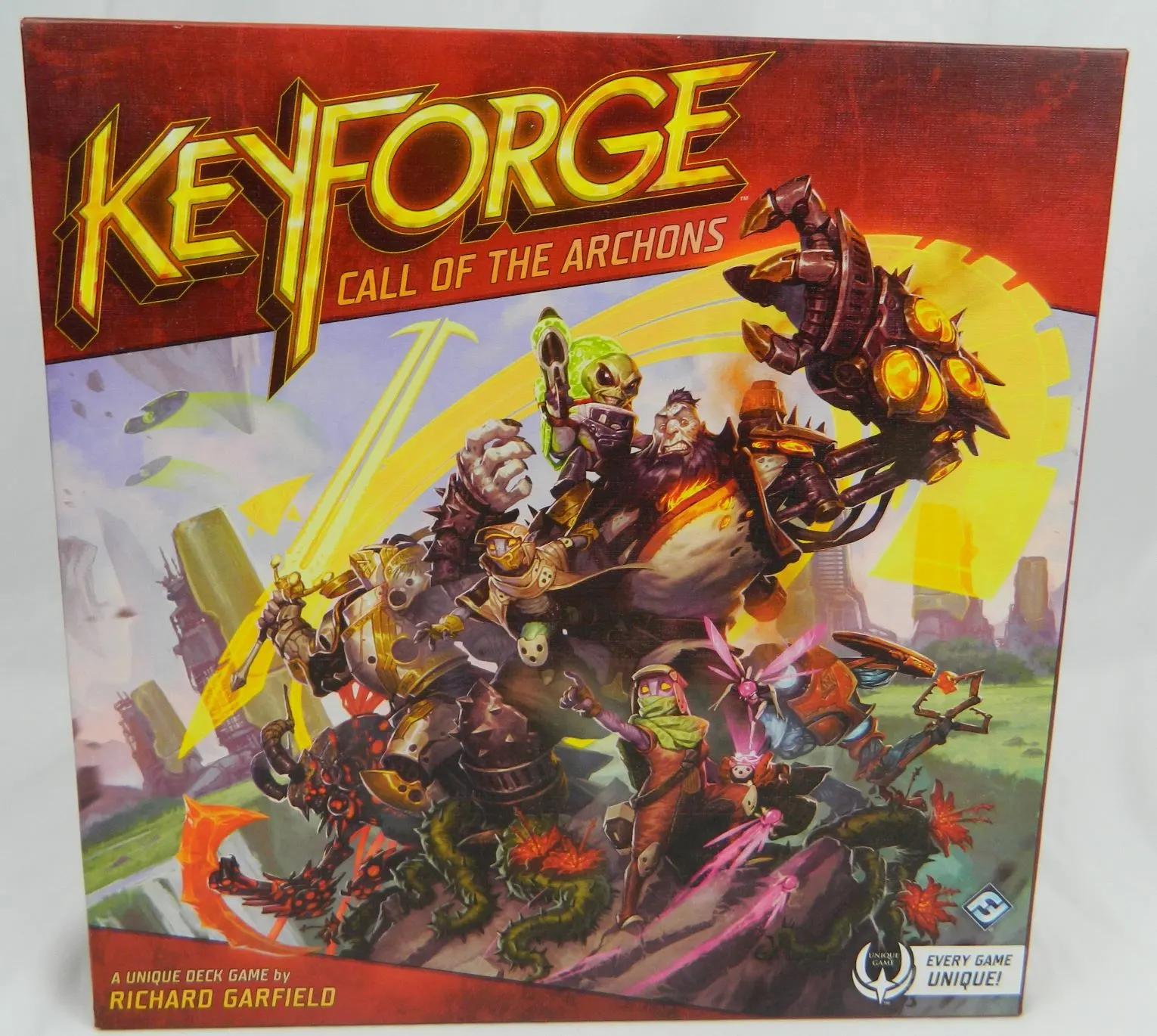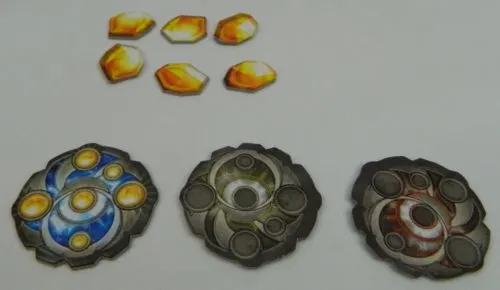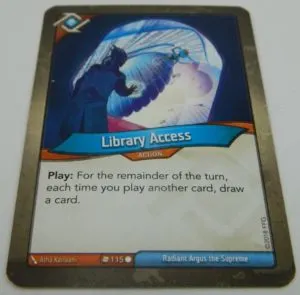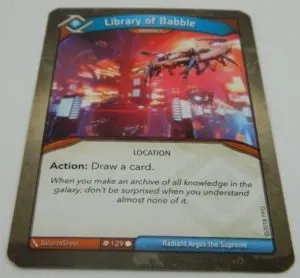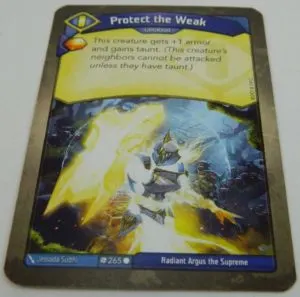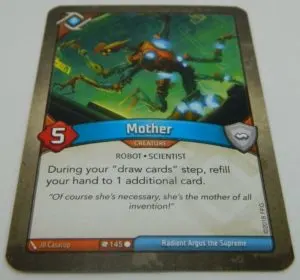When I was a kid I was a pretty big fan of Collectible Card Games (CCGs). Pokemon was my favorite, but I also enjoyed a number of less popular games in the genre. I eventually grew out of them mostly because of the cost. Buying so many packs of cards just to try and get good cards to improve a deck got old after a while. One CCG that I am familiar with but never really got into was Magic the Gathering. I think I would really enjoy the game, but the CCG model doesn’t really appeal to me anymore. I am more interested in the living card game genre which basically takes the CCG and instead of buying random boosters, you buy expansions. Today I am taking a look at KeyForge: Call of the Archons which originally came out in 2018. The concept behind the game really intrigued me. The game was designed by Richard Garfield, designer of Magic the Gathering, and features pre-built decks sold like booster packs. What is truly unique is that every deck in the world is different as they are created by a computer algorithm. KeyForge: Call of the Archons is an interesting twist on your typical CCG improving it in some ways while having some of its own issues.
How to Play KeyForge Call of the Archons
Setup
- Each player chooses a deck to play. For your first game it is recommended that one player play as Miss “Onyx” Censorius and the other as Radiant Argus the Supreme. Otherwise players can choose any pre-assembled deck.
- Each player will set their identity card on the table next to them on the side showing the character’s name and the three symbols.
- Each player will take three key tokens and turn them to the unforged (less colorful) side.
- The rest of the players’ cards will be shuffled to form their draw deck.
- Place the AEmber tokens, damage tokens and status cards in a pile to the side where both players can reach them.
- Randomly choose who will start the game. The first player will draw seven cards while the second player will draw six cards.
Playing the Game
The current/active player will follow five steps on their turn:
- Forge a Key
- Choose a House
- Play, Discard, and Use Cards of the Active House
- Ready Cards
- Draw Cards
Forge A Key
To begin your turn you will check to see how many AEmber tokens you have. If you have six of more Aember you will turn in six of them to turn over one of your key tokens to the forged (more colorful) side. The AEmber you use will be returned to the supply. If you have the six AEmber you must take this action even if you don’t want to.
Only one key can be forged each turn even if a player has enough to forge two or more keys.
Choose a House
Each of the decks have three different houses. Every card in the deck belongs to one of the three houses. You will choose one of these three houses to make the active house for the rest of your turn. The player will only be able to play and use cards for the rest of their turn from the house that they choose.
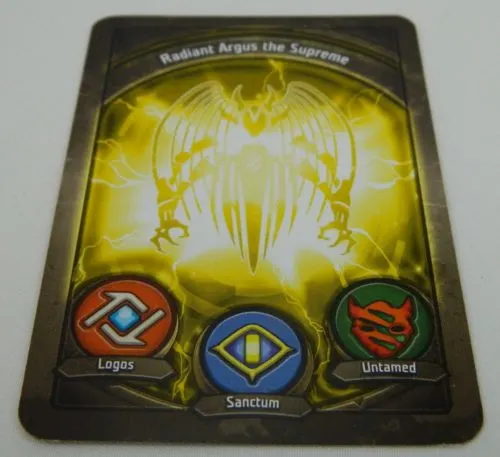
The Radiant Argus the Supreme player will choose one of the three houses pictured at the bottom of this card. The house they choose will determine what cards they can use and play on their turn.
Play, Discard, and Use Cards of the Active House
During this step you will be able to take most of your actions. Based on the house you chose in the previous step you will get to play, discard and use cards that match the house you chose. You may take as many actions as you want. The one exception to this is on the first turn of the game the player may only play or discard one card from their active house.
Playing Cards
When you choose to play a card the only rule is that it has to be of the active house for the current turn. You may play as many cards on your turn as you want as long as they are of the active house.
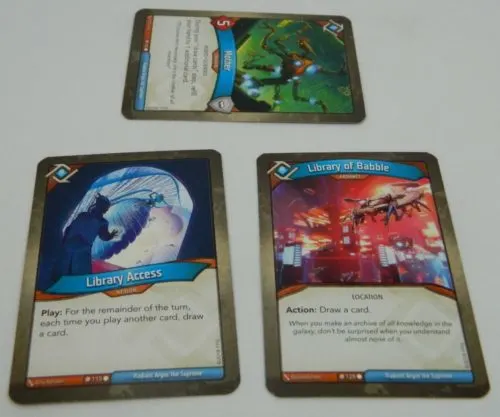
For this round the player choose the Logos house. These three cards match their chosen house so they were able to play them.
Some of the cards in the game will feature the AEmber symbol along the left edge. When these cards are played, you will take one AEmber from the supply and add it to your pool.
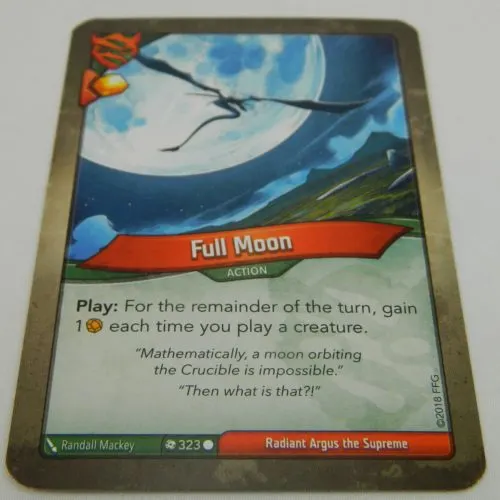
This card features the AEmber symbol in the top left corner. When this card is played the player will collect one AEmber from the supply.
When a card is played with text on the bottom that says “play”, you will take the corresponding action immediately after any AEmber bonus is collected.
Types of Cards
There are four types of cards which impact what happens when the card is played.
Action cards are played for the action printed on the card. After this action is taken the card is added to the player’s discard pile.
Artifacts will be placed behind a player’s “battleline”. These cards will remain in play unless they are discarded due to another card that is played. Artifacts enter play exhausted.
When an upgrade card is played you will choose a creature card to attach it to. You will place the card behind the chosen creature in a way where you can still read the text on the upgrade card. Upgrades remain attached to the creature until the creature leaves play. When this happens the upgrade is discarded.
Creature cards are played to a line in front of a player known as the “battleline”. When you add a creature card it will either be added to the left or right (flank) of all of the creature cards that the player currently has in their battleline. All creature cards are played in the exhausted state.
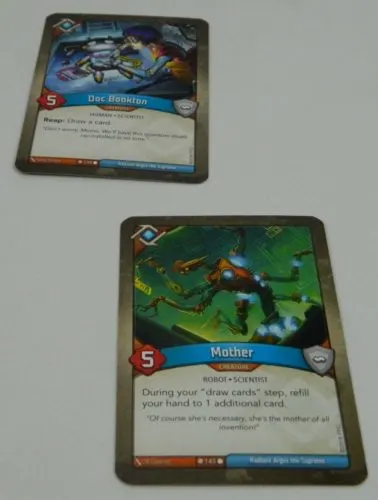
This player had already played Doc Bookton. When they play the Mother card they will either play it to the left or right of Doc Bookton.
If a creature leaves play, the creatures on each side will fill in the gap in the battleline that was created.
Discarding Cards
A player may choose to discard as many cards from their hand as they want if they match the active house. This allows a player to get rid of cards that they won’t use in order to draw more cards at the end of their turn.
Using Cards
In order to use a card it must be in the ready state. You can use as many cards as you want on your turn as long as they belong to the active house. There are three different ways that a card can be used.
Reaping
Any creature that is ready can be used to “Reap”. The card is turned to the exhausted state and you take an AEmber from the supply and add it to your pool. If the creature you used has a “Reap” ability you will perform that action as well.
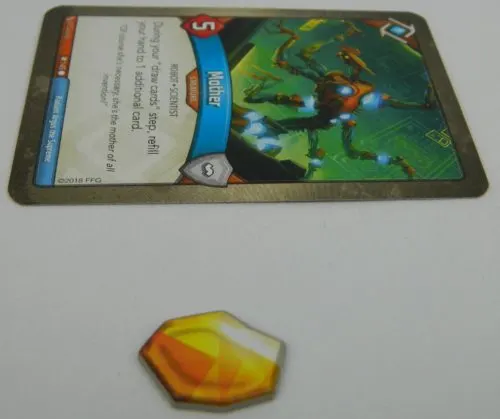
This player has decided to use the Mother card for the Reap action. By choosing this action the player will take one AEmber from the supply and turn the card to the exhausted state.
Action Abilities
If an artifact, upgrade or creature card has an action ability you can choose to exhaust the card in order to take the associated action. If a card is exhausted you can’t use its action ability.
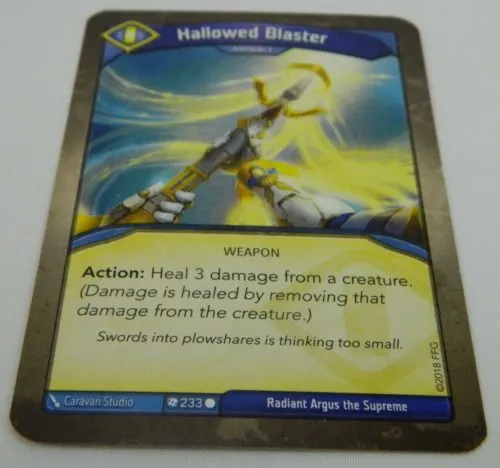
On each turn that the player chooses the corresponding house, they can use this card’s action ability to heal three damage from a creature.
Fighting
The last action that you can take with a creature card is to use it to fight. Any creature that is ready can be used to fight. You will choose which creature you want to fight with and which opponent creature you want to attack.
During a battle each creature will deal damage to one another based on their power rating (the number in the red symbol on the left side of the card). This is reduced by the armor rating (number in the gray shield on right side of the card) of each creature. Each player will take a number of damage tokens equal to the amount of damage done to their creature and will place them on the associated card. If the damage dealt to a creature is higher than its strength, the creature is destroyed and discarded.
If the attacking creature survives the fight, you will get to take the creatures “Fight” action.
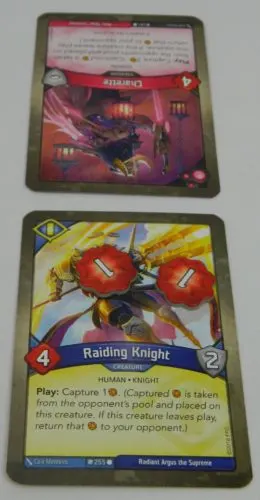
The player who played the Raiding Knight has decided to attack. Since its strength is 4 it will deal four damage to the other creature defeating it. The other creature has an attack of four which will be reduced to two damage due to the Raiding Knight’s defense. The top creature will be moved to the other player’s discard pile, while the Raiding Knight will stay in play.
Ready Cards
All cards played to the table will be in one of two states: ready or exhausted. Generally for a card to be used it must be in the ready state. When a card is used its state changes from ready to exhausted. This is indicated by turning the card. When a card is first played it is generally played as exhausted.
This step of a player’s turn has a player turn all of their exhausted cards to the ready state to prepare for their next turn.

On this turn the player used the Doc Bookton and Mother cards. During this step they will turn the cards to the ready state so they can be used on the player’s next turn.
Draw Cards
You will end you turn by drawing cards from your deck until there are six total cards in your hand. If you already have six or more cards in your hand, you will keep the cards but won’t be able to draw additional cards.
If a player’s draw pile ever runs out of cards, the discard pile is shuffled to create a new deck to draw from.
Before ending your turn you will check to see how much AEmber you have. If you have six or more tokens you will tell the other player “Check” to let them know that you will be able to forge a key at the beginning of your next turn. Play then passes to the other player.
Winning the Game
The first player to forge all three of their keys (have them turned to the colorful side) wins the game.
My Thoughts on KeyForge: Call of the Archons
Before I begin I want to say that while this is technically a review of KeyForge: Call of the Archons, in many ways it is a review of KeyForge in general as well. KeyForge: Call of the Archons is basically a series of cards that utilize the KeyForge gameplay system. The game I am looking at today is pretty much a starter set and an introduction to the larger game. You can buy additional decks for the game that take cards from the same pool, but form their very own deck. Each set of cards have their own little twists, but the main gameplay is pretty much the same between all of the games.
In a lot of ways KeyForge: Call of the Archons feels a lot like your typical CCG. That is not all that surprising as the game was designed by Richard Garfield who popularized the whole genre when he came up with Magic the Gathering. While it has its own little twists which I will get into soon, the basic core of the game shares a lot in common with a lot of games from this genre. Each player has their own deck of cards which they will play cards from in order to beat their opponent. Players take turns playing cards for their abilities as well as forming a group of creatures in front of themselves which can be used on future turns. Each card has it own unique abilities which players need to utilize together in order to create useful combos. Basically if you have ever played a CCG before, you should already have a good idea of what to expect from KeyForge. For this reason your feelings towards the genre in general will likely apply to KeyForge: Call of the Archons as well.
There are a couple areas where the game does differentiate itself though.
First in a way I would say that the game has less of a focus on combat than a lot of CCGs. The game has combat and it still plays a big role in the game, but it is not all there is to the game. In most games from this genre you win by defeating the other player’s creatures and depleting their overall health. Thus success in combat is a driving force behind winning the game. You don’t have any sort of health in KeyForge: Call of the Archons as instead you are trying to unlock keys to win. You can acquire the AEmber required to unlock keys through combat, but it can be acquired in a number of other ways as well. You can acquire AEmber just by having creatures out in front of you or even through the use of certain cards. You can also steal AEmber from the other player at times.
I found this to be an interesting twist to the typical formula for CCGs. I don’t mind combat, but it is not always my favorite mechanic. I generally like the idea of giving players a number of different ways of acquiring AEmber other than just using your creatures to defeat the other players’ creatures. Creating good combos with your cards is key. Giving players other things to focus on gives players more options in my opinion. You can’t ignore combat as your creatures are an important tool to acquiring AEmber, but you don’t have to focus on it entirely. The game shares a lot in common with most CCGs in many ways, but this does a good job distinguishing the game in some interesting ways.
I think KeyForge: Call of the Archons’ greatest strength is that it actually creates some interesting gameplay strategies. Each deck seems to have its own emphasis where the decks can actually play quite a bit different. To illustrate lets look at the two starter decks that come with the game. One of the decks has a greater emphasis on creatures allowing you to control the battlefield so you can generate AEmber from the creatures that you are able to play out in front of you. The other deck has a greater emphasis on using special abilities to control the battlefield and even stealing AEmber from the other player. While the basic gameplay is the same, how you approach the game with both of these decks can be quite different. Quite a bit of your success in the game will come from how well you use your cards’ abilities together. Good use of your cards’ abilities can go a long way towards improving your odds of winning the game.
As for the game’s difficulty, I would say that it is light to moderate. The basic gameplay is actually quite simple. Each of the steps you follow each turn is quite straightforward and the overall objective of the game is quite simple. I would say that most of the game’s difficulty comes from the cards themselves. The game is quite dependent on the cards themselves and thus relies on quite a bit of reading and figuring out the best way of using cards together. Like a lot of these type of games, the amount of decisions that you have to make with all of the different card abilities can sometimes lead to some analysis paralysis.
Probably the biggest difference in KeyForge: Call of the Archons though comes from the “house” mechanic. Most CCGs use a sort of energy system. Some of the cards in your deck will be energy cards. You play these cards in order to create a pool of energy that you can then use on future turns to either play or use cards. Basically what you can do on any turn is based on the amount of energy that you have available to you. KeyForge: Call of the Archons ditches energy entirely. Instead all of the cards in each of the decks are part of one of three houses. You choose one house for each turn and then can use, play or discard as many cards of that house that you want on your turn. Basically what you can do on your turn is only limited by the number of cards that you have of your chosen house.
This is the mechanic of KeyForge: Call of the Archons that I was the most intrigued by even though I have some mixed feelings about it. I genuinely credit the mechanic as it is unique for the genre. One of the biggest issues with CCGs that use energy is that if you don’t draw the right types of energy early on, you are basically severely limited on what you can do. KeyForge: Call of the Archons gets around this because you don’t have to draw specific cards in order to play the cards that you want. I liked this aspect of the game since if you have a card that you like in your hand, as long as you choose the corresponding house you can play it. You don’t have to hope that you draw a specific card in order to implement your current strategy.
The one drawback to this though is that the breakdown of the cards in your hand and in front of you can play a pretty big impact on how well you do in the game. For the most part you benefit from having a lot of cards of the same house in your hand and out in front of you. This is because if you choose that house you will be able to perform more actions on your turn. The opposite holds true though if your cards are evenly split between the three houses. In one case you might be able to play and use five plus cards and in the other case you may only be able to play two or three. Generally the more cards that you are able to play/use, the more you can do on a turn which should improve your chances of winning. The player that draws more cards of the same house more regularly will likely have an advantage in the game that can sometimes be hard to overcome.
This illustrates my biggest issue with KeyForge: Call of the Archons. Ultimately the game can rely on quite a bit of luck at times. Pretty much every CCG relies on a decent amount of luck. This is because card draw luck plays a big role in how well you will do. Some cards are more powerful than others, and every card has their own time when they are most effective. If you draw the right cards at the right times, it will be much easier to win the game than if you can’t draw the cards that you are looking for. An added wrinkle to this due to the “house” mechanic is that you really want to draw cards of the same house as it will allow you to take more actions on your turn. You still need to play your cards well in order to win as poor use of your cards will likely lead to defeat. There will be games though where you basically have no chance of winning because card draw luck is not on your side.
This brings me to the decks themselves. KeyForge: Call of the Archons is interesting because in a way it takes elements from both a CCG with booster packs and a living card game. Instead of purchasing expansions or booster packs, you basically purchase decks one at a time. Each deck comes pre-built and you can’t take cards from one deck and add them to another deck. Due to a computer algorithm every deck in the world is apparently different as the cards selected for each are randomly selected following some parameters so the decks actually make some sense.
In theory this is a really interesting idea. No two players will ever use the exact same deck. Each character has their own emphasis with cards selected for its deck based on that emphasis. I liked a lot of things about this premise. First you don’t have to waste your time trying to craft your own perfect deck. This will be a turnoff for some players as they actually like spending the time building a deck. I was never a huge fan of this though so I like the idea that you can jump right into a game. You also don’t have to waste a bunch of money buying booster packs where you might only end up using one or two cards from the pack. Each deck you purchase can be used by itself and will give you an unique experience.
The one thing that I kind of question about this idea is how balanced the decks ultimately are. In a way it feels like some decks are just built better than others. A computer algorithm can do a decent job making a deck that works together, but some combinations that it comes up with are better than others. I would say the algorithm does a commendable job, but a player may have an advantage just because their deck is slightly better. This isn’t helped by the reliance on luck. Two decks could be balanced on paper, but things can change drastically when luck enters the equation. You will play games where it is a blowout because one player just had better luck than the other. In these situations there really isn’t anything that you could do to make it better. Thus some games of KeyForge: Call of the Archons will be better than others.
As for the game’s overall components, the game is pretty much what you would expect from this genre. The starter set that this review is based on comes with the two starter sets, two other randomized decks, and the tokens that you need to keep track of what is going on in the game. The card quality is what you would expect as they are sturdy enough that they should last as long as you aren’t too rough with them. In general I enjoyed the artwork as it looks nice and the cards are setup in a way where it is easy to find the information that you need. Generally speaking I thought the components were pretty good.
Should You Buy KeyForge: Call of the Archons?
While it is not perfect, I generally enjoyed KeyForge: Call of the Archons. The game shares a lot in common with your typical CCG, but is different as well. Instead of trying to deplete your opponent’s health through combat, the goal of the game is to acquire AEmber through combat and other means. I found this to be an interesting twist on the genre as it gives you different ways of approaching the game outside of just focusing on combat. The idea of trading energy for playing/using cards of your chosen house was an interesting twist as well. This allows you to play/use a specific card on your turn no matter what, but it does add some luck as the type of cards you draw impacts how many actions you can take on your turn. I generally liked the strategy element of KeyForge: Call of the Archons as each deck has its own emphasis and they can actually play quite a bit different. The game still relies on quite a bit of luck though. The idea that every single deck is assembled by an AI so each is different is a cool idea in concept and works pretty well. It does seem like some decks are better than others though.
My recommendation for KeyForge: Call of the Archons relies a lot on your feelings toward CCG games in general. If you don’t really like the gameplay that is prevalent in these type of games, I don’t think KeyForge: Call of the Archons is different enough to change your mind. If you like the genre though and are looking for an interesting twist on it, I think you will enjoy KeyForge: Call of the Archons and should consider picking it up.
Buy KeyForge: Call of the Archons online: Amazon (Starter Set, Booster Deck
), eBay
. Any purchases made through these links (including other products) help keep Geeky Hobbies running. Thank you for your support.

